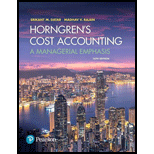
Concept explainers
Budgeting; direct material usage,
Xander blue rugs are very popular and demand is high, but because of capacity constraints the firm will produce only 200,000 blue rugs per year. The budgeted selling price is $2,000 each. There are no rugs in beginning inventory. Target ending inventory of rugs is also zero.
Xander makes rugs by hand, but uses a machine to dye the wool. Thus,
There is no direct manufacturing labor cost for dyeing. Xander budgets 62 direct manufacturing labor-hours to weave a rug at a budgeted rate of $13 per hour. It budgets 0.2 machine-hours to dye each skein in the dyeing process.
The following table presents the budgeted overhead costs for the dyeing and weaving cost pools:
| Dyeing | Weaving | |
| (based on 1,440,000 MH) | (based on 12,400,000 DMLH) | |
| Variable costs | ||
| Indirect materials | $ 0 | $15,400,000 |
| Maintenance | 6,560,000 | 5,540,000 |
| Utilities | 7,550,000 | 2,890,000 |
| Fixed costs | ||
| Indirect labor | 347,000 | 1,700,000 |
| |
2,100,000 | 274,000 |
| Other | 723,000 | 5,816,000 |
| Total budgeted costs | $17,280,000 | $31,620,000 |
- 1. Prepare a direct materials usage budget in both units and dollars. Required
- 2. Calculate the budgeted overhead allocation rates for weaving and dyeing.
- 3. Calculate the budgeted unit cost of a blue rug for the year.
- 4. Prepare a revenues budget for blue rugs for the year, assuming Xander sells (a) 200,000 or (b) 185,000 blue rugs (that is, at two different sales levels).
- 5. Calculate the budgeted cost of goods sold for blue rugs under each sales assumption.
- 6. Find the budgeted gross margin for blue rugs under each sales assumption.
- 7. What actions might you take as a manager to improve profitability if sales drop to 185,000 blue rugs?
- 8. How might top management at Xander use the budget developed in requirements 1–6 to better manage the company?
Learn your wayIncludes step-by-step video

Chapter 6 Solutions
Horngren's Cost Accounting: A Managerial Emphasis (16th Edition)
Additional Business Textbook Solutions
Business Essentials (12th Edition) (What's New in Intro to Business)
Financial Accounting: Tools for Business Decision Making, 8th Edition
Intermediate Accounting (2nd Edition)
Principles of Operations Management: Sustainability and Supply Chain Management (10th Edition)
Essentials of Corporate Finance (Mcgraw-hill/Irwin Series in Finance, Insurance, and Real Estate)
 Managerial AccountingAccountingISBN:9781337912020Author:Carl Warren, Ph.d. Cma William B. TaylerPublisher:South-Western College Pub
Managerial AccountingAccountingISBN:9781337912020Author:Carl Warren, Ph.d. Cma William B. TaylerPublisher:South-Western College Pub Financial And Managerial AccountingAccountingISBN:9781337902663Author:WARREN, Carl S.Publisher:Cengage Learning,Principles of Accounting Volume 2AccountingISBN:9781947172609Author:OpenStaxPublisher:OpenStax College
Financial And Managerial AccountingAccountingISBN:9781337902663Author:WARREN, Carl S.Publisher:Cengage Learning,Principles of Accounting Volume 2AccountingISBN:9781947172609Author:OpenStaxPublisher:OpenStax College


